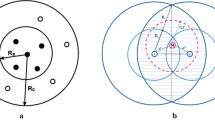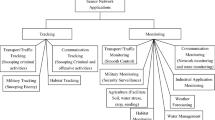Abstract
The emergence of wireless sensor networks is counted among the most significant achievements of the late 20’s. Nowadays, by the ever increasing utilization of new technologies, accessibility of distributed processing technologies and the rising demand for these technologies in regions unreachable or hard-to-reach for humans, their application is greatly expanded. In this study, the objective application is target tracking in protected zones. In this respect, tracking and accurate position reporting of targets in the defined time unit is the main objective. Nevertheless, one of the challenges in these networks is their short lifetime. This is due to the energy limitation of the power supply in each unit. The topic of target tracking in wireless sensor networks is of great importance because on one hand, for their lack of recharge ability, sensor nodes get depleted quite quickly, while on the other hand, losing the target is a highly undesirable event that may severely hamper the functionality of the network. Thus, we are searching for a solution that minimizes tracking errors. In this paper, we propose a strategy for target tracking in wireless sensor networks that is able to generate the least possible tracking error while consuming the minimum energy.






Similar content being viewed by others
References
Mirsadeghi, M., & Mahani, A. (2014). Low power prediction mechanism for wsn-based object tracking. Procedia Technology, 17, 692–698. https://doi.org/10.1016/j.protcy.2014.10.271.
Jabeen, F., & Fernandes, A. A. (2012). An algorithmic strategy for in-network distributed spatial analysis in wireless sensor networks. Journal of Parallel and Distributed Computing, 72(12), 1628–1653. https://doi.org/10.1016/j.jpdc.2012.09.005.
Li, H., Sun, Z. and Lu, K., 2014. Real-Time Tracking for Moving Target in WSN with Uncovered Holes. In Human Behavior Understanding in Networked Sensing (pp. 75-97). Springer, Cham, https://doi.org/10.1007/978-3-319-10807-0_4.
Naderan, M., Dehghan, M., & Pedram, H. (2013). Upper and lower bounds for dynamic cluster assignment for multi-target tracking in heterogeneous WSNs. Journal of Parallel and Distributed Computing, 73(10), 1389–1399. https://doi.org/10.1016/j.jpdc.2013.04.007.
Płaczek, B., & Bernaś, M. (2014). Uncertainty-based information extraction in wireless sensor networks for control applications. Ad Hoc Networks, 14, 106–117. https://doi.org/10.1016/j.adhoc.2013.11.009.
Bahrpeyma, F., Golchin, B., & Cranganu, C. (2013). Fast fuzzy modeling method to estimate missing logsin hydrocarbon reservoirs. Journal of Petroleum Science and Engineering, 112, 310–321. https://doi.org/10.1016/j.petrol.2013.11.019.
Kung, H.T. and Vlah, D., 2003, March. Efficient location tracking using sensor networks. In 2003 IEEE Wireless Communications and Networking, 2003. WCNC 2003. (Vol. 3, pp. 1954-1961). IEEE, https://doi.org/10.1109/wcnc.2003.1200686.
Zhang, W., & Cao, G. (2004). DCTC: dynamic convoy tree-based collaboration for target tracking in sensor networks. IEEE Transactions on wireless communications, 3(5), 1689–1701. https://doi.org/10.1109/TWC.2004.833443.
Heinzelman, W.R., Chandrakasan, A. and Balakrishnan, H., 2000, January. Energy-efficient communication protocol for wireless microsensor networks. In Proceedings of the 33rd annual Hawaii international conference on system sciences (pp. 10-pp). IEEE, https://doi.org/10.1109/hicss.2000.926982.
Vasuhi, S., & Vaidehi, V. (2016). Target tracking using interactive multiple model for wireless sensor network. Information Fusion, 27, 41–53. https://doi.org/10.1016/j.inffus.2015.05.004.
Kulathumani, V., Arora, A., Demirbas, M. and Sridharan, M., 2007, January. Trail: A distance sensitive wsn service for distributed object tracking. In European Conference on Wireless Sensor Networks (pp. 83-100). Springer, Berlin, Heidelberg, https://doi.org/10.1007/978-3-540-69830-2_6.
Mirsadeghi, M. and Mahani, A., 2015. Energy efficient fast predictor for WSN-based target tracking. annals of telecommunications-annales des télécommunications, 70(1-2), pp.63-71, https://doi.org/10.1007/s12243-014-0430-y.
Wang, Z., Li, H., Shen, X., Sun, X. and Wang, Z., 2008, April. Tracking and predicting moving targets in hierarchical sensor networks. In 2008 IEEE International Conference on Networking, Sensing and Control (pp. 1169-1173). IEEE, https://doi.org/10.1109/icnsc.2008.4525393.
Wang, H., Ren, W., & Cui, Y. (2012). An adaptive WSN node tracking algorithm based on rough-set neural network. Procedia Engineering, 29, 1750–1754. https://doi.org/10.1016/j.proeng.2012.01.207.
Dutta, R., Saha, S., & Mukhopadhyay, A. K. (2012). Tracking heterogeneous dynamic sensor node using fuzzy logic to prolong system lifetime in WSN. Procedia engineering, 38, 522–527. https://doi.org/10.1016/j.proeng.2012.06.065.
Wang, Y., Yang, J., Yang, X. and Zhang, D., 2008, July. MTT-Mobicast: maneuvering target tracking mobicast protocol for wireless ad hoc sensor networks. In 2008 8th IEEE International Conference on Computer and Information Technology (pp. 821-826). IEEE, https://doi.org/10.1109/cit.2008.4594780.
Tynan, R., O’Hare, G.M., O’Grady, M.J. and Muldoon, C., 2009, June. EDLA tradeoffs for wireless sensor network target tracking. In 2009 29th IEEE International Conference on Distributed Computing Systems Workshops (pp. 440-446). IEEE, https://doi.org/10.1109/icdcsw.2009.59.
Sarna, S.K. and Zaveri, M., 2010, July. ERTA: energy efficient real time target tracking approach for wireless sensor networks. In 2010 Fourth International Conference on Sensor Technologies and Applications (pp. 220-225). IEEE, https://doi.org/10.1109/sensorcomm.20https://doi.org/10.41.
Tsukamoto, K., Ueda, H., Tamura, H., Kawahara, K. and Oie, Y., 2009, January. Design of wireless sensor network for multi-point surveillance of a moving target based on the relationship between tracking probability and sensor density. In 2009 6th IEEE Consumer Communications and Networking Conference (pp. 1-5). IEEE, https://doi.org/10.1109/ccnc.2009.4784913.
Jeong, J., Hwang, T., He, T. and Du, D., 2007, May. Mcta: Target tracking algorithm based on minimal contour in wireless sensor networks. In IEEE INFOCOM 2007-26th IEEE International Conference on Computer Communications (pp. 2371-2375). IEEE, https://doi.org/10.1109/infcom.2007.283.
Darabkh, K. A., Ismail, S. S., Al-Shurman, M., Jafar, I. F., Alkhader, E., & Al-Mistarihi, M. F. (2012). Performance evaluation of selective and adaptive heads clustering algorithms over wireless sensor networks. Journal of Network and Computer Applications, 35(6), 2068–2080. https://doi.org/10.1016/j.jnca.2012.08.008.
Author information
Authors and Affiliations
Corresponding author
Additional information
Publisher's Note
Springer Nature remains neutral with regard to jurisdictional claims in published maps and institutional affiliations.
Rights and permissions
About this article
Cite this article
Hosseini, R., Mirvaziri, H. A New Clustering-Based Approach for Target Tracking to Optimize Energy Consumption in Wireless Sensor Networks. Wireless Pers Commun 114, 3337–3349 (2020). https://doi.org/10.1007/s11277-020-07534-5
Published:
Issue Date:
DOI: https://doi.org/10.1007/s11277-020-07534-5




